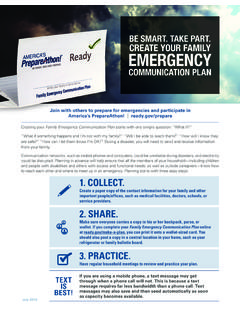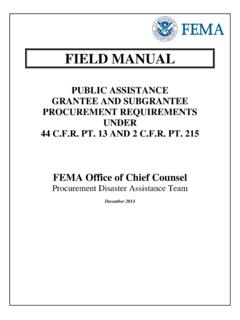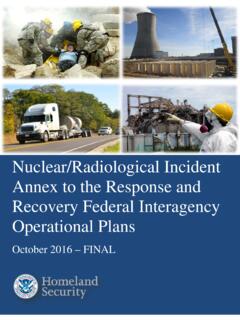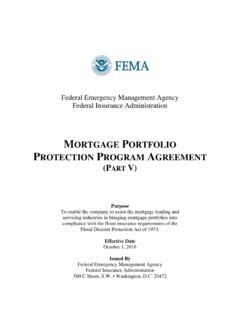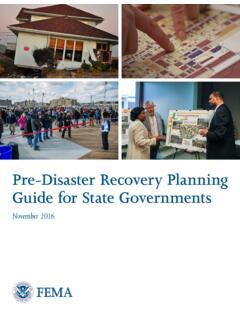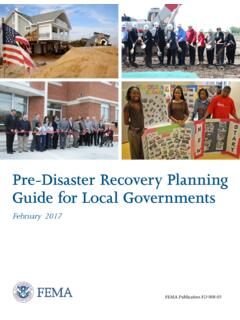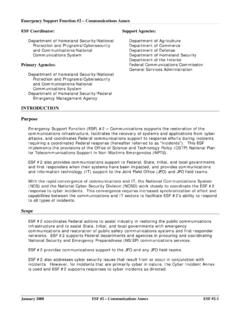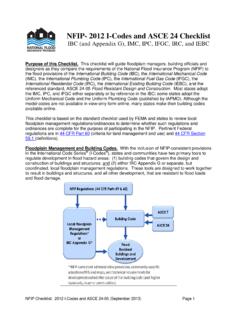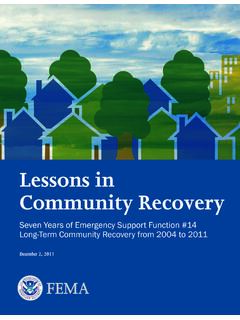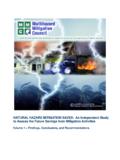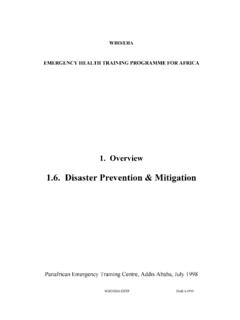Transcription of Homeowner's Guide to the Hazard Mitigation Grant Program
1 Homeowner s Guide to the Hazard Mitigation Grant Program This brochure answers some common questions homeowners have about implementing post-disaster projects that reduce future damage to their home. What is Hazard Mitigation ? Hazard Mitigation is any action taken to reduce or eliminate long-term risk to people and property from natural hazards and their effects. What types of projects are available for consideration for FEMA funding? Mitigation projects include: Acquisition and Structure Demolition/Relocation The community buys, with FEMA funding, the property from the homeowner and demolishes or relocates any structures on the proper t y.
2 Elevation The home is raised so potential floodwaters may flow underneath the home. Mitigation Reconstruction The existing home is demolished and anew, elevated home is constructed. Dry Floodproofing of HistoricResidential Structures The home isprotected with barriers to prevent floodwater from entering. Structural Retrofitting of ExistingBuildings Enhancements are madeto a home to make it more resistant toflood, wind, earthquakes, and/or fire. Residential Safe Room A safe roomis constructed inside or close to thehome to provide safety from strongwinds, such as those experiencedduring a tornado. Wildfire Mitigation Fire resistantmaterials are used on the exterior ofthe home and trees or brush are clearedto remove flammable materials fromaround the home.
3 Wind Retrofit Enhancements aremade to strengthen the roof, walls,doors, and windows and minimizedamage caused by high FEMA offer any financial assistance for Hazard Mitigation projects? The Federal Emergency Management Agency s (FEMA) Hazard Mitigation Grant Program (HMGP) helps communities implement Hazard Mitigation measures following a Presidential major disaster declaration. The objective is to support cost -effective measures during recovery that will reduce the risk of physical and social impacts from future disasters. Who can apply for HMGP funding? Generally, local communities sponsor applications on behalf of homeowners and apply to the State.
4 Because funds are limited, only projects that meet local and state priorities are forwarded to FEMA. Homeowners cannot apply directly for HMGP funding. Below is a list of governments and organizations that can sponsor an application: States Territories Federally -recognized tribes Local communities Private non -profit organizations - ----- -What is the process of applying for HMGP? HMGP funding may be available after a Presidential major disaster declaration. The funding amount is calculated from a percentage of the overall disaster damage (refer to the Hazard Mitigation Assistance Guidance for more information).
5 States, territories, or federally recognized tribal governments administer the Program and prioritize projects. Because HMGP funding is limited, they must make difficult decisions as to the most effective use of Grant funds. After reviewing project applications to determine if they meet the Program s requirements, the states, territories, or federally recognized tribal governments forward the applications to FEMA for review and approval. FEMA awards the HMGP funds to the Applicant, which disburses those funds to its subapplicants, generally the local governments are responsible for implementing the project and are required to meet all federal, state and local procurement procedures as well as meet codes and standards.
6 Homeowners may start their projects once notified by their local/ tribal/state government official. Work started prior to FEMA review and approval is ineligible for funding. Please contact your State Hazard Mitigation Officer, or federally recognized tribal/local government official to obtain information on the HMGP application process. FEMA maintains a list of State Hazard Mitigation Officers at BEFORE AFTER Project example House Elevation Freeport, New York 1. Disaster Strikes The President of the United States declares a disaster for the State or Tribal Government and federal disaster aid becomes available. For a list of major disaster declarations, please visit 2.
7 Research Point of Contact Generally, homeowners can contact their State/local emergency management department to find their Mitigation point of contact. In some cases, the state/tribal/local emergency management department advertises information on Mitigation opportunities through: Town hall meetings Local papers Media outlets (radio, televisions, billboards, etc.) State/local websites 3. Research the HMGP Homeowners can refer to Program for information on project types and general Program requirements. Be sure your community wants to participate in the HMA Program in order to submit a Grant application to FEMA. 4. Decision to Apply to the HMGP Applying for HMGP funding is voluntary.
8 Homeowners must decide whether to apply for HMGP assistance, mitigate their homes using other funding sources, or not mitigate. Homeowners should consider all of their options and seek assistance in developing a plan that may include applying for HMGP funding. 5. Application Development Generally, local governments develop applications. The applications are submitted to the state, territory, or federally recognized tribal government and then to FEMA. *States, territories, federally recognized tribes or local governments may decide not to apply for HMGP funding. In that case, homeowners must seek funding from other sources in order to implement Mitigation measures to their homes.
9 6. FEMA Review FEMA reviews the submitted applications for: eligibility, cost effectiveness, feasibility, and environmental laws and regulations that may impact the project. The applications that meet these Program requirements may be approved based on funding availability. 7. Project Implementation FEMA awards funds to the Applicant, which disburses the funds to its local governments. Homeowners may start their projects once notified by their state/tribal/local government official. 8. Project Completion Once the project is completed, closeout begins. Closeout is a process by which FEMA reviews and verifies that the project meets all of the Program s and federal Grant management requirements.
10 What are common Do s and Don ts? Do contact your Mitigation point of contact. Contact your State Hazard Mitigation Officer, federally recognized tribe, or local government official to obtain information on the HMGP application process. Do consider other funding sources. The HMGP application process may take several months. Do NOT start work until receiving notification from your state/ tribal/local government official. FEMA does not reimburse costs for work already started or completed prior to FEMA review and approval. This does not include basic repair work to make your residence habitable; rather, it includes risk reduction costs that would be funded by the Mitigation Grant .
